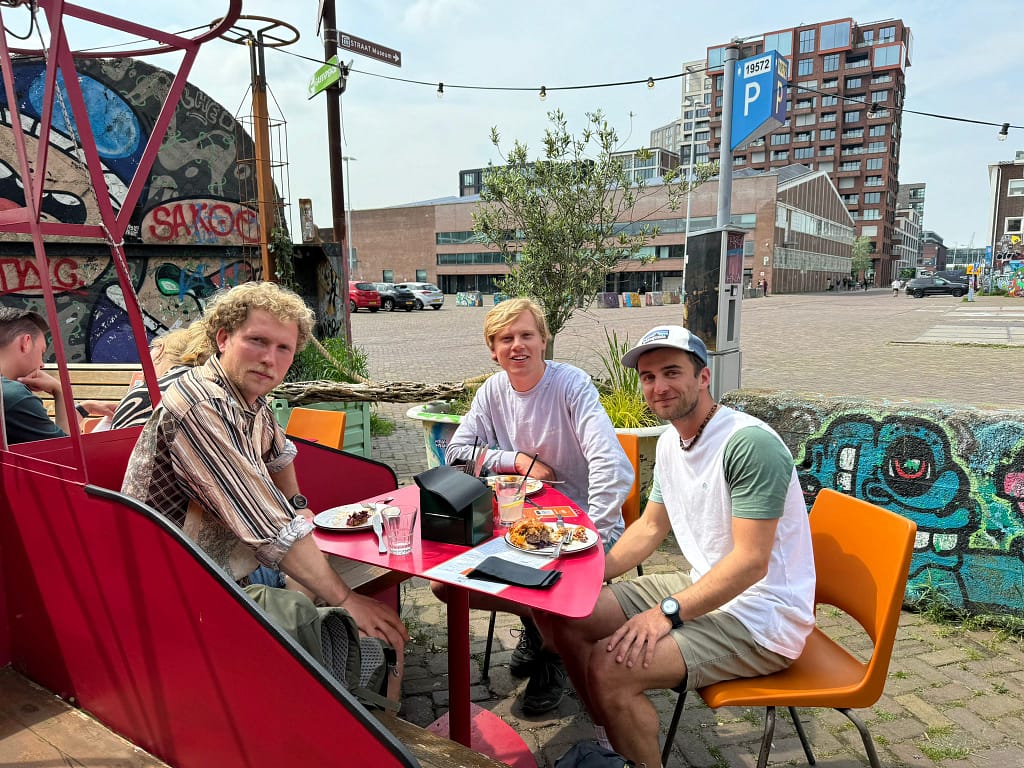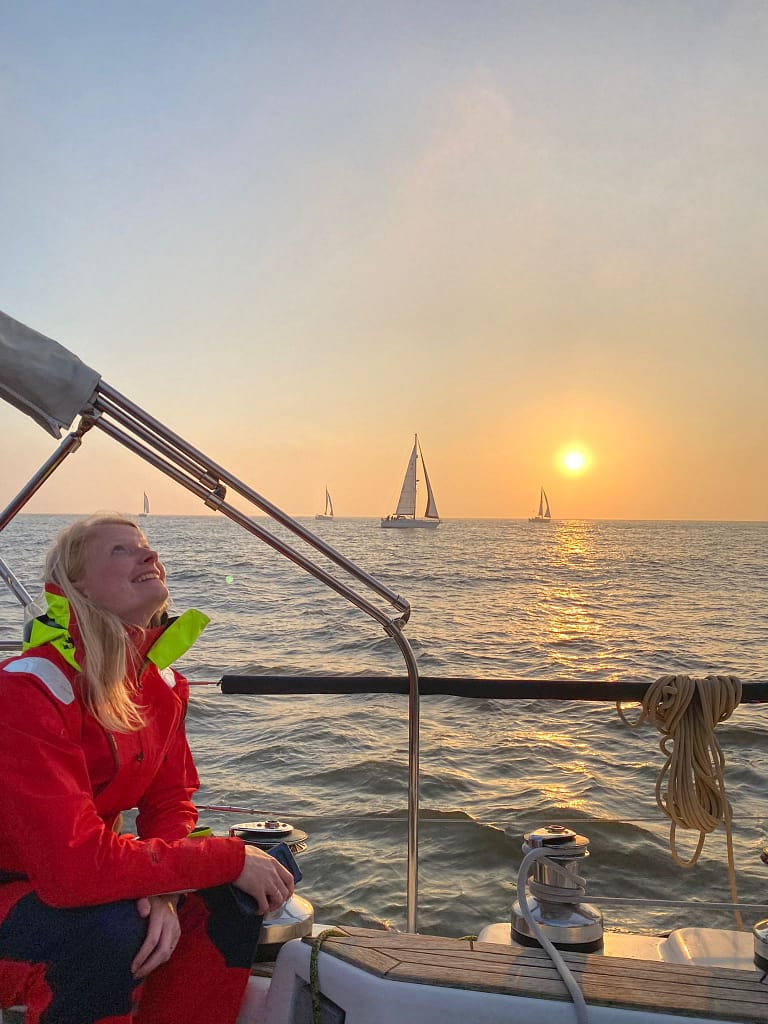I was walking with a pounding heart and a big smile towards the overnight Flixbus bound for Amsterdam and adventure. Trine was carrying a 100L backpack filled with jackets, head torches, clothes, a toothbrush, and other essentials that might be useful when you’re gone for a couple of years. I, on the other hand, was wearing a bulky diving bag with a 15L scuba bottle made from hard steel to test our air compressor, a pressure cooker full of underwear (clean), and a lot of different spare parts that all tried hard to give me a back injury. I put three bags and a framed world map into the trunk of the bus without the bus driver blinking an eye—that’s another good reason for taking the bus instead of the plane. 😉
While the Flixbus was making its way south, the Earth spun fiercely towards the East, causing the sun to dip below the horizon in a beautiful sunset. I thought to myself that we’d witness heaps of these in the next couple of years. A wave of joy washed over me with the thought that this bus was driving us towards the start of our epic journey. It would begin with Coen and me sailing the boat to Ijmuiden, ready for a trip over the English Channel with Femke, and three of Coen and Femke’s friends: Wouter, Jelle, and Bart.
Coen and I had a bit of a tight schedule in Amsterdam as there were a couple of things on the boat we needed to fix (autopilot, hinges, etc.) and some spare parts we wanted to buy before heading over to the land of fish & chips. However, we did manage to find a few hours to meet up with an old friend of ours, Ondrej, whom we met in Brisbane. Ondrej is an absolute bird expert who can tell you everything about a bird from the sound of its singing and the shape of its beak. He is now working with Theunis Piersma, a former Spinoza prize winner, on birds in the Waddenzee. We reminisced over old memories and caught up on the last five years over some beers, before Coen and I made our way to Ijmuiden.

Leaving Ijmuiden - Preparing for Lowestoft
For those of you who don’t know Ijmuiden, it is what we in Danish would call ‘a hole in the ground.’ Let’s just say that the place has, um, a unique charm to it, with chimneys greeting us with the aroma of hard industry. In Ijmuiden, we met up with Femke, Wouter, Bart, and Jelle the next day (Friday) and started our first crossing with Eva to Lowestoft on the other side of the British Channel.
Lowestoft is pretty much the British counterpart of Ijmuiden. Some people on TripAdvisor describe it in the following way: ‘The arse end of England,’ ‘Awful town, awful people, hated every second there; the only nice thing about the place is the road out,’ ‘Shockingly bad.’ One person even described the city with these
words: ‘What an uninspiring dump. Lowestoft, the town you will never leave because the inbred locals will hunt you down and stick you in a giant Wicker Man. There’s nothing for strangers there. If you are lucky enough to escape, you will require therapy to get over the experience.’ An old Danish sailor used to say, ‘Happiness lies where reality meets expectations’ — and with these reviews, happiness shouldn’t be too hard to find😉.
Bart, Jelle, and Wouter are all experienced sailors and good lads, as they’d say in the pubs of Lowestoft. So, the crew was more than ready to take on the trip across the channel, which we expected to last close to 24 hours—perfect for crossing the channel. With the Atlantic Ocean squeezing water back and forth through the channel, the tides become quite strong. However, with exactly two high and two low tides during the 24 hours, all we needed to do was head west to reach Lowestoft.
We’d informed the weather gods beforehand that this would be Eva’s first crossing, to which they replied with a firm wind from the north, allowing us to set sail once and sail with a beam reach (90 degrees to the wind) directly to England. We couldn’t have asked for better weather, so all we needed to do was trim the sails (which Jelle is an absolute champion at), dodge the many big ships crossing the channel, and have fun—all of which we had absolutely no problems with. With a group of six friends, and Bart as the DJ, we guaranteed good fun!
Before the night dawned upon us, we sailed into thick fog that lasted more or less the whole way to Lowestoft. This, of course, made sailing markedly more challenging as you can no longer see other boats, or potential squalls or thunderstorms approaching. However, this is where modern navigation instruments come in handy. With our electronic chart, we can see the depth and potential shallow areas, buoys, wrecks, and other markers. With our AIS (a connected VHF and GPS network), we can keep track of the position, course, and speed of all other boats. These two instruments alone make it infinitely safer to sail in such conditions. Now, we mostly have to worry about floating containers and other unmarked features, along with potential boats that sail without an AIS system, which you rarely see in these latitudes except for a few, usually smaller, sailing boats or people committing to underhanded dealings who really don’t want to be seen. But for these obstacles, we have the radar, an instrument that I personally love, which enables us to detect these kinds of features as they reflect back the signal we transmit and show up like a dot on our electronic chart as well.
The fog really got us talking about how incredibly more difficult it was sailing years ago, and how courageous old sailors were without modern navigation instruments, reliable weather predictions and apps, and without Gore-Tex jackets. I think you’d have to be halfway mad to be a sailor two hundred years ago, no wonder they were seeing mermaids every second night.
Anyway, after 16 hours of sailing at an average speed of a staggering 9.3 knots, we made our way to the god-forsaken city of Lowestoft, where big industrial buildings and a single windmill welcomed us through the mist that had eased a bit throughout the night. With Coen at the rudder and all men (our only woman was sleeping) on deck, we made our way 2 nautical miles up the Waveney river, that runs through Lowestoft, where we found a spot at the local harbor. None of us had the best night, especially not Coen, who always follows the situation with one eye open—I guess that’s a captain’s lot. So, we all went to bed again and slept until the late morning, where we had a slow-paced breakfast, got a shower, and so on.




Lowestoft - A fishing town left behind
While I stayed at the boat fixing a few things, the rest of the team ventured into the city to see what Lowestoft had to offer. Naturally, they visited a local pub to enjoy a cold beer and some fish & chips (with some very sad peas)—a mandatory experience in seaside towns in England. After soaking up the raw British atmosphere, they continued on to the Lowestoft Maritime Museum. Apparently, Lowestoft was originally a small beach village that underwent a dramatic transformation in the late 1800s when the fishing industry boomed, attracting thousands of people and causing the city to expand significantly.
The herring season in late autumn brought in some 10,000 people annually, including 6,000 Scotswomen known as the ‘Herring Lassies.’ These herring-girls moved south following the fishing fleets, traveling from port to port, gutting, pickling, and packing herring by the millions. They worked in teams of three: two would gut the fish, and the tallest girl—the one who could reach the bottom of the barrel with ease—would have the task of filling them. They worked from 5 in the morning into the late afternoon, gutting up to 60 herrings a minute! The herring industry finally collapsed in the 1960s due to overfishing, marking the end of the herring girls and their great migration. By the early 2000s, the fishing industry had completely died, leaving behind a city that was too big for its inhabitants.
Another interesting fact learned at the museum is about the Battle of Lowestoft, which took place on June 13, 1665, early in the Second Anglo-Dutch War. This day is noted as a significant loss for the Dutch—’something that all Dutch people remember,’ as the museum puts it. Ironically, probably only a few Dutch people would have heard anything about the date, in which the Dutch suffered a small loss in a war that was eventually won by them.
In the evening, I joined the group at the local games and bowling hall, where Wouter taught us all how to handle big bowling balls, while we sampled local cheese sticks, fries, and beers. You’ve got to try the local specialties, after all. After bowling, we enjoyed some great Indian food before strolling back through the roads of outer Lowestoft to Eva, who was gently rocking in the harbor waiting for us.
Even though Lowestoft might not be regarded as the center of the world, we still had a fun time and enjoyed experiencing everyday life in an English city outside the major urban hubs like London, Manchester, and Liverpool. That’s the great thing about sailing—it takes you to places you might never otherwise visit!
The trip back was even more pleasant than the journey to Lowestoft. We made our ‘Brexit’ just before sunrise and returned to the EU right after sunset. Upon reaching Ijmuiden again we enjoyed some drinks and played a lot of games to celebrate the last night on the boat, before we would say goodbye to Wouter, Jelle, and Bart and welcome Nena the day after who would join us on our way north towards Denmark.













Great post, storytelling and photos!